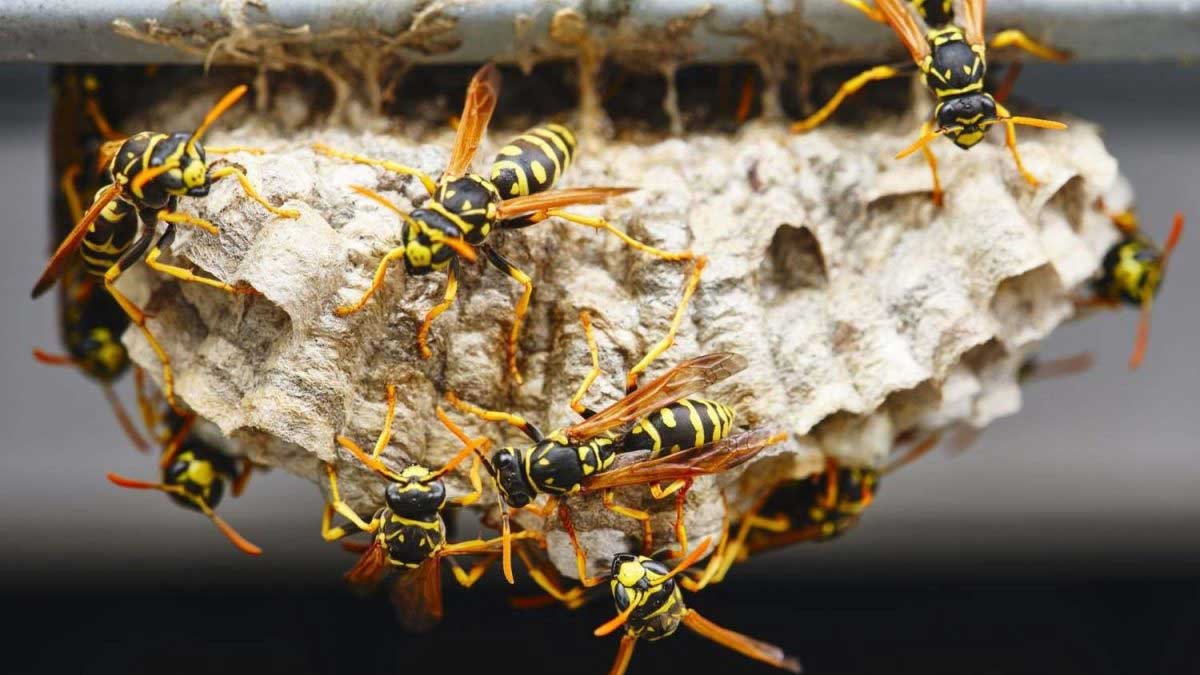Professional Wasp Nest Control in Gloucester and Cheltenham
Wasp Nest Removal Services
About Wasps
There are several species of wasps here in the UK, with the two most common being the German wasp (Vespula germanica) and the native common wasp (Vespula vulgaris).
These two species are very similar in size and appearance, with only their markings being an identifying feature. Wasps are social insects that closely work together to build their nests and feed their queen their young. Wasps will build their nests in various sheltered locations, including in the ground, in flower beds, in garden sheds, and even in a property’s loft space.
Both Common and German wasps are most active during the warmer temperatures, which is usually from the months of spring through to early autumn. This is when they will typically forage for food, build their nests, and raise their queen’s young.
In the colder months the wasps begin to die off, with the queen taking shelter to hibernate over winter before starting the process over again

Wasp Nest Control and Removal
PestEx Professional Pest Control offer a same-day wasp nest control and removal service. Unlike a bee’s nest, wasps nests are only ever used once, so when they are treated they do not usually require removal. In fact, it can be better to leave the treated nest intact, as wasps are known to sometimes attempt to rebuild a nest nearby, even without a queen.
If removal is required, this is usually done 24-48 hrs after the nest has been treated. This enables all of the workers to return to the treated nest and to come into the insecticide and die. Where if the nest is removed, the workers return, realise their nest has gone and attempt to rebuild another nearby.
Wasp Prevention
Wasps are often found foraging around for food to take back to their nests. They will often forage for protein and sugary foods. The sight of a wasp can startle people because of their known aggressive nature and painful sting. Some people are known to have a severe reaction to wasp stings, causing anaphylactic shock, which can be life threatening. Throughout the warmer months, people who are known to have a severe allergic reaction to wasp stings will carry an epipen to administer, should they be unfortunate enough to be stung. These are adrenaline auto-injector (AAI) used for self-administration of emergency treatment of anaphylaxis. They cost around £85 and have a shelf life of approximately two years.
Wasp prevention can be as simple as cleaning up spilt sugary drinks, keeping food covered, especially when outside enjoying the weather, and ensuring bin bags are tightly sealed. Inspecting your property for wasp nests will also reduce the risk of getting stung by wasps. If you are confronted by a wasp, it is important not to panic by erratically lashing out and attempting to squash it. Wasps are known to be very aggressive, and attacking it will provoke an angry response that will likely result in someone getting stung. If confronted by a foraging wasp, it is strongly advisable to slowly and calmly back away. If the wasp feels threatened, it will go on the offensive.
If you or someone you know is unfortunate enough to be stung, if either of you begins to exhibit signs of a severe allergic reaction, you should immediately seek medical assistance. Something as simple as being stung by a wasp can potentially be life threatening.
Distinguishing Between Wasps and Honey Bees

From a distance, honey bees and wasps can be hard to distinguish from one from another. However, there are key differences in the phyicial characterics between the two species.
When it comes to distinguishing between wasps and honey bees, it is important to understand the key differences in their physical characteristics. Although both wasps and bees belong to the order Hymenoptera, they exhibit unique features from one another that set the two species apart.
Unlike the wasp’s relatively smooth thorax and adomen, a bee’s body is more hairy. One of the main differences between wasps and honey bees is their appearance. Wasps are typically slender with smooth bodies, while honey bees are more robust with hairy bodies.
Wasps are also brighter yellow, with prominent black stripes across its thorax and adomens, while honey bees tend to be more uniform shade of yellowly brown with thicker black legs.

